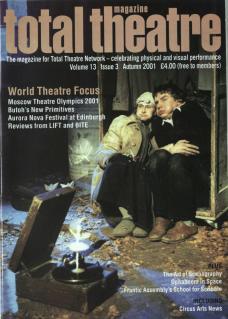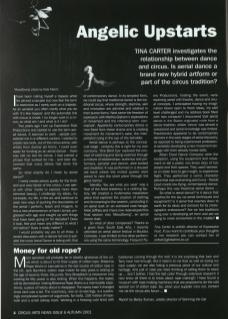I have been calling myself a trapeze artist for almost a decade but now feel the term is restrictive as I rarely work on a trapeze. As an aerialist you often clarify what you do with 'it's like trapeze' and the automatic link with circus is made. I no longer work in a circus, so what am I and what is it I do?
Two years ago I set up Expressive Feat Productions and started to use the term aerial dance. It seemed to work – people considered me in a different context. I started to create new work, out of the circus arena, with artists from diverse artforms. I could even apply for funding as an aerial dancer – there was still no box for circus. I had coined a phrase that worked for me – and later discovered that many others had done the same.
So what exactly do I mean by aerial dance?
I rarely create pieces purely for the thrill, skill and wow factor of the circus; I use aerial with other media to express more than ethereal beauty, I challenge my ideas, my concepts, my life, in the air, and continue to seek new ways of pushing the boundaries of the aerial I perform, teach and imagine. Is this a new phenomenon or have I simply progressed with age and caught up with things that have been going on for decades? Does it look, feel and mean any different to what I did before? Does it really matter?
I would probably say yes to all three. A recent discussion with a dancer led me to parallel the route Aerial Dance is taking with that of contemporary dance. In its simplest form, we could say that traditional dance is like traditional circus, where strength, stamina, skill and innovation are admired and relished in their purest forms. Next came the freedom of expression with Martha Graham's explorations of movement and the infamous term 'conceptual'. Apparently contemporary dance is now freed from these chains and is creating movement for movement's sake, the interpretation lying in the eye of the beholder.
Aerial dance is perhaps at the conceptual stage – certainly this is right for my own company. One Blind Eye explored the concept of watching and being watched through a mixture of relationships: audience and performers, aerialist and dancer, able-bodied and disabled. It was performed in a disused old bank where the invited guests were asked to view the short piece through the glass barrier.
Identity: You are what you wear was a Year of the Artist residency in a clothing factory. We created a multimedia installation piece that explored the creation of clothing and its meaning to the wearers, concluding in an aerial duet on an oversized coat-hanger. Nikki Jeffries and I have now redeveloped this final section into MoodSwing, an aerial dance duet.
So what of other companies? Thanks to a grant from South East Arts, I recently attended an aerial dance festival in Boulder, Colorado. I was thrilled to find other performers using the same terminology. Frequent Flyers Productions, hosting the event, were exploring aerial with theatre, dance and visual concepts. I anticipated having my imagination blown open to fresh ideas, my skill level challenged and my address book filled with new contacts! I discovered that aerial dance in the States originated more from a dance tradition, where 'circus' was almost a swearword and aerial knowledge was limited. Practitioners appeared to be contemporary dancers in the early stages of aerial discovery, as opposed to being experienced professional aerialists developing a new movement language with their already honed skills.
Alban Elved Dance Company were the exception, using the equipment and movement to tell a poetic non-linear story of two people and their spaces. They used harnesses on static lines to gain height, to experience flight. They performed a comic character piece that was enchanting and funny – Harold Lloyd meets low-flying, contemporary dance. Perhaps this was theatrical aerial dance...
So what is aerial dance? Is it dance that reaches for the sky via aerial techniques and equipment? Is it aerial that reaches down to earth for its ideas and dancers for its choreographic endeavours? Are we two traditions vying over a developing artform and are we going to meet somewhere in the middle?
Tina Carter is artistic director of Expressive Feat. If you want to contribute your thoughts to her research you can contact her at exfeat@globalnet.co.uk

